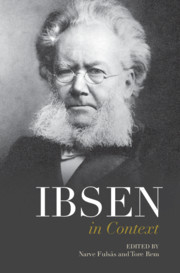Book contents
- Ibsen in Context
- Ibsen in Context
- Copyright page
- Contents
- Figures
- Contributors
- Preface
- Notes on the text
- Chronology
- Part I Life and Career
- Part II Culture and Society
- Part III Scandinavian Reception
- Part IV Internationalization
- Part V Afterlives
- Chapter 24 Biographies
- Chapter 25 Academic Responses
- Chapter 26 American Ibsens
- Chapter 27 Japanese Ibsens
- Chapter 28 Chinese Ibsens
- Chapter 29 Indian Ibsens
- Chapter 30 Mass Media and Popular Reception
- Further Reading
- Index
Chapter 30 - Mass Media and Popular Reception
from Part V - Afterlives
Published online by Cambridge University Press: 23 April 2021
- Ibsen in Context
- Ibsen in Context
- Copyright page
- Contents
- Figures
- Contributors
- Preface
- Notes on the text
- Chronology
- Part I Life and Career
- Part II Culture and Society
- Part III Scandinavian Reception
- Part IV Internationalization
- Part V Afterlives
- Chapter 24 Biographies
- Chapter 25 Academic Responses
- Chapter 26 American Ibsens
- Chapter 27 Japanese Ibsens
- Chapter 28 Chinese Ibsens
- Chapter 29 Indian Ibsens
- Chapter 30 Mass Media and Popular Reception
- Further Reading
- Index
Summary
This contribution explores the ‘afterlives’ of Ibsen and his works within mass media and popular culture. Arguing that adaptations to popular media both promote and problematize the status and cultural capital of the works or of the dramatist, this chapter explores examples of remediations through film, television, comics and the tourist industry. Cinematic examples span from Oscar Apfel’s 1915 filmatization of Peer Gynt to Steven Spielberg’s Jaws from 1975, which builds on An Enemy of the People. The section on television production maps how Ibsen’s plays shaped the new medium in Norway. The section on comics explores the recent explosion of Ibsen-related projects, spearheaded by acclaimed graphic novelist David Zane Mairowitz’s 2014 collaboration with Norwegian comics artist Geir Moen. The contrast between tourist attractions that depict Ibsen’s life and those that seek to immerse visitors in a fictive world, such as the A Doll’s House exhibition, frames the section on museums and tourism. Long viewed as irrelevant to the study of Ibsen, these areas are attracting increasing attention, both because they are interesting in their own right, and because they have become important forms of cultural production and engagement in the late modern era.
- Type
- Chapter
- Information
- Ibsen in Context , pp. 264 - 271Publisher: Cambridge University PressPrint publication year: 2021
- 1
- Cited by

